|
|
|
Sort Order |
|
|
|
Items / Page
|
|
|
|
|
|
|
| Srl | Item |
| 1 |
ID:
131521
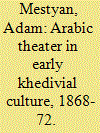

|
|
|
|
|
| Publication |
2014.
|
| Summary/Abstract |
This article revisits the official culture of the early khedivate through a microhistory of the first modern Egyptian theater in Arabic. Based on archival research, it aims at a recalibration of recent scholarship by showing khedivial culture as a complex framework of competing patriotisms. It analyzes the discourse about theater in the Arabic press, including the journalist Muhammad Unsi's call for performances in Arabic in 1870. It shows that the realization of this idea was the theater group led by James Sanua between 1871 and 1872, which also performed ?Abd al-Fattah al-Misri's tragedy. But the troupe was not an expression of subversive nationalism, as has been claimed by scholars. My historical reconstruction and my analysis of the content of Sanua's comedies show loyalism toward the Khedive Ismail. Yet his form of contemporary satire was incompatible with elite cultural patriotism, which employed historicization as its dominant technique. This revision throws new light on a crucial moment of social change in the history of modern Egypt, when the ruler was expected to preside over the plural cultural bodies of the nation.
|
|
|
|
|
|
|
|
|
|
|
|
|
|
|
|
| 2 |
ID:
132538
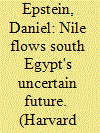

|
|
|
|
|
| Publication |
2014.
|
| Summary/Abstract |
As US citizens celebrated their independence and self-rule on July 4, 2013, they opened their newspapers to find that Egyptians had surrendered theirs. The previous day, amid impassioned protests across the country against the Muslim Brotherhood-led government, the Egyptian Armed Forces removed President Mohammad Morsi from power. For a time, the move dominated headlines. Columnists, academics, and statesmen debated the ethics and ramifications of the coup. But soon, the world moved on. Despite Egypt's vital ongoing struggle to build a nation, coverage of the effort moved out of the mainstream. Now, almost nine months later, Egypt deserves a second look. In late January 2011, Hosni Mubarak, who had governed Egypt since 1981, was overthrown after weeks of mass protest across the country. In the November elections the Muslim Brotherhood, previously illegal, was swept into power with 52 percent of the vote. In June 2012, Muhammad Morsi, a member of the Brotherhood, became the first freely elected President in Egyptian history. Egypt's (seemingly) successful transition to civilian rule drew accolades from the international community. Another victory for democracy. But things were not as rosy as they seemed.
|
|
|
|
|
|
|
|
|
|
|
|
|
|
|
|
| 3 |
ID:
131534
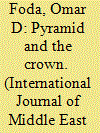

|
|
|
|
|
| Publication |
2014.
|
| Summary/Abstract |
This paper focuses on a long-running and understudied Egyptian economic institution, the beer industry. While the presence of a well-developed beer industry in a predominantly Muslim country is noteworthy in itself, it is the consistent profitability of this industry despite the vicissitudes of Egypt's economic and political development that have made it truly remarkable. Relying heavily on archival material, including documents preserved in Cairo's Dar al-Watha?iq (Egyptian National Archives), this paper tracks the development of the beer industry in Egypt from 1897, when Belgian entrepreneurs started the Pyramid and Crown breweries, to the 1960s, when the Egyptian government nationalized the two companies. This analysis uses the history of the beer company to map larger social and economic trends in the colonial and semicolonial Egyptian economy (1882-1963) and to further problematize the foreign/Egyptian dichotomy that shapes discussions of it.
|
|
|
|
|
|
|
|
|
|
|
|
|
|
|
|
| 4 |
ID:
133703
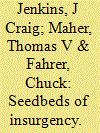

|
|
|
|
|
| Publication |
2014.
|
| Summary/Abstract |
Studies of insurgency and collective action are divided between structural and dynamic explanations. Structural theories address the presence of insurgency while dynamic theories focus on the frequency of insurgent actions. Yet prior studies often treat these arguments additively, leaving unclear how structural and dynamic processes affect these different aspects of insurgency. This study addresses this division by using zero-inflated negative binomial regression to examine in a single equation both the presence and the count of Islamist insurgency in Egyptian governorates between 1986 and 1999. We test political economy, moral economy, and cultural clash explanations of the presence of insurgency alongside political dynamics arguments about repression and exclusion to explain the count of attacks. Looking at the structural side of this equation, we find that communities with high rates of poverty, child mortality, cultural conservatism in terms of low contraceptive prevalence, and greater urban density are more likely to support insurgency. Looking at the dynamic side, parliamentary exclusion, security sweeps, and executions affect the count of attacks along with spatial diffusion from neighboring governorates. The culturally conservative region of Upper Egypt, which has a history of social and political marginality and opposition, provided a seedbed of insurgent support but this challenge broke down over time as repression intensified and exclusion was relaxed. These findings underscore the point that the presence of and the intensity of insurgency are distinct and driven by different factors. There are notable methodological and theoretical advantages to distinguishing between presence and count to better understand when and where insurgencies develop and their level of collective action.
|
|
|
|
|
|
|
|
|
|
|
|
|
|
|
|
| 5 |
ID:
131559
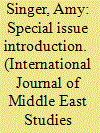

|
|
|
|
|
| Publication |
2014.
|
| Summary/Abstract |
Almost two decades ago, Michael Bonner, Mine Ener, and I organized the first in a series of MESA panels on the general theme of poverty and charity in Middle Eastern contexts. We came to the topic using different chronologies, sources, and approaches but identified a common field of interest in shared questions about how attitudes toward benevolence and poverty affected state and society formation: in early Islamic thought, in the Ottoman Empire of the 15th and 16th centuries, and in khedival Egypt. At that time, we could confidently state that there was very little work in the broad field of Middle East and Islamic studies that focused explicitly on the study of charity and poverty.
|
|
|
|
|
|
|
|
|
|
|
|
|
|
|
|
| 6 |
ID:
130936
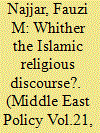

|
|
|
|
|
| Publication |
2014.
|
| Summary/Abstract |
For more than two centuries, Muslims have been struggling to cope with the challenges of the scientific, technological, political and cultural civilization of the West. Modernization has been thrust upon them by colonialism as well as by globalization in general. To modernize has been somewhat inescapable. The more pressing question agitating the Muslim mind has been how to modernize and remain Muslim, as Muhammad Abdou, a leading Egyptian modernist, put it more than a century ago.
|
|
|
|
|
|
|
|
|
|
|
|
|
|
|
|
|
|
|
|
|